
WASHINGTON, July 17 (Xinhua) -- Many U.S. experts remained optimistic about China's economic prospect, despite the fact that the growth rate for the world's second largest economy has slowed to 7.5 percent in the second quarter this year, marking the 11th slowdown out of the past 13 quarters.
SLOWER BUT MORE SUSTAINABLE
Every economy slows down at the end of the take-off phase. China now "gets to a point where applying more and more investment doesn't work," Douglas Paal, vice president for studies at Carnegie Endowment for International Peace, told Xinhua.
"China can avoid a hard landing," but the more important issue is to generate "productivity and to escape that middle income trap, " said Paal, adding "it's possible to make it but many countries have failed. China now faces a transition period over a number of years out of the take-off and into a more stable growth model."
The current slower growth rate "should be sustainable over an extended period of time," Stapleton Roy, director of Kissinger Institute on China and the United States at Wilson Center and U.S. Ambassador to China from 1991 to 1995, told Xinhua.
"Having a relatively sustainable rate of growth that would meet the needs of providing employment for the new people entering the workforce, but at the same time would not generate all of the difficulties that overly rapid growth produced," Roy continued.
REFORM MATTERS
The recent global financial crisis has shown that the growth rate in China is not simply an outcome of domestic factors, but also dependent on external factors, which are out of China's control.
"One of the goals in the 12th five-year plan is to try to shift the relative weight of exports as opposed to domestic consumption in favor of domestic consumption," said Roy, adding "If the growth of China's economy is based more on domestic consumption it will be less subject to external shocks."
This economic transition is especially important, as in the case of the United States and Europe in the last few years, when the period of deleveraging has replaced the expensive periods of liquidity growth in the previous decade.
"China could have another decade of substantial growth rates perhaps at seven to eight percent," if it implements the range of measures "that have been discussed in the financial reform and tax reform and the registration of households reforms, creating new social security nets," said Bonnie Glaser, senior adviser for Asia at Center for Strategic and International Studies.
Certainly reforms will not take place all at once. "This is going to have to be done slowly and there going to be winners and losers in China," said Glaser, adding the Chinese government "will have to scrutinize their impact and adjust as they go forward and China has this phrase of feeling the stones as you cross the river. "
"Ultimately it's not all about the rate of growth, it's about the quality of growth," Glaser noted.
China's key economic statistics in H1:
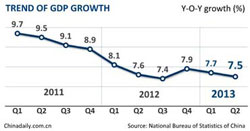 |
 |
| Q2 GDP growth slows to 7.5% | H1 retail sales accelerate to 12.7% |
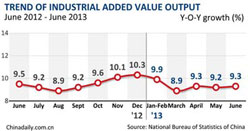 |
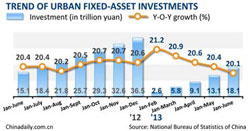 |
| H1 industrial output up 9.3% | FAI up 20.1% in H1 |
 |
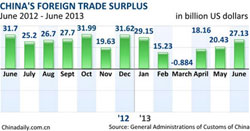 |
| Fiscal revenue rises 7.5% in H1 | Export down 3.1% in June |
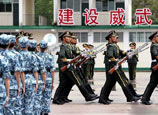







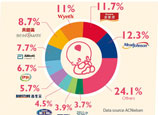







 116-year-old Chinese woman recognized as world's oldest
116-year-old Chinese woman recognized as world's oldest


![]()
